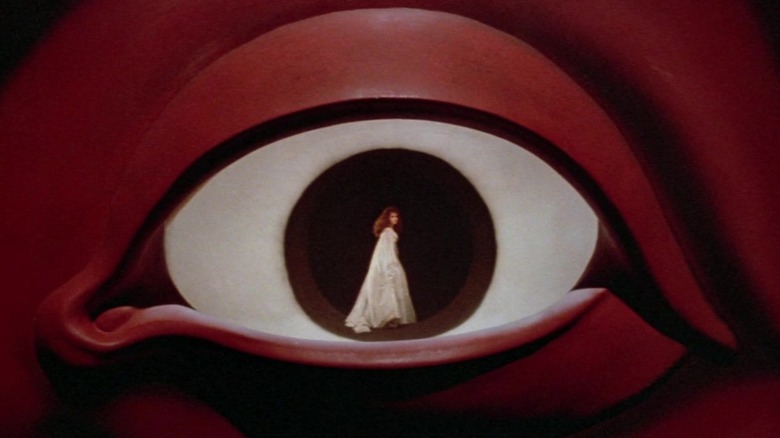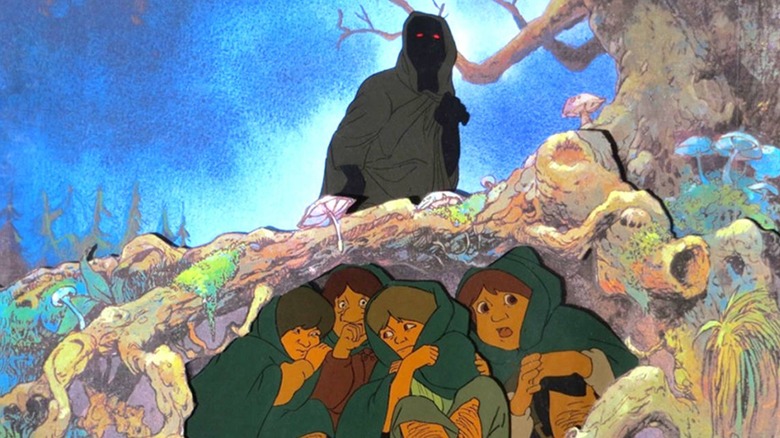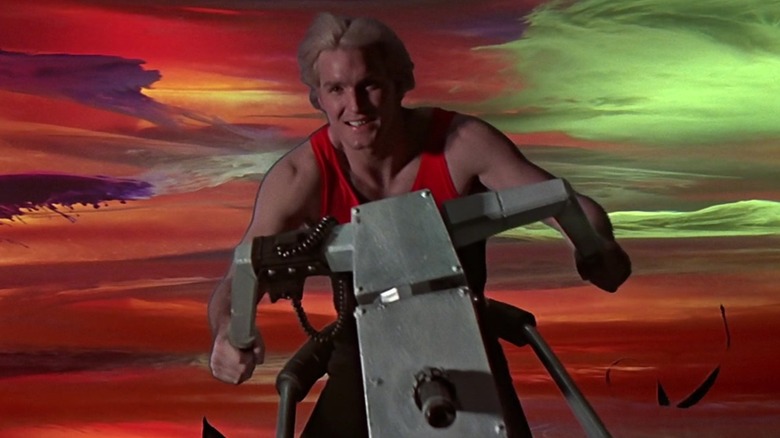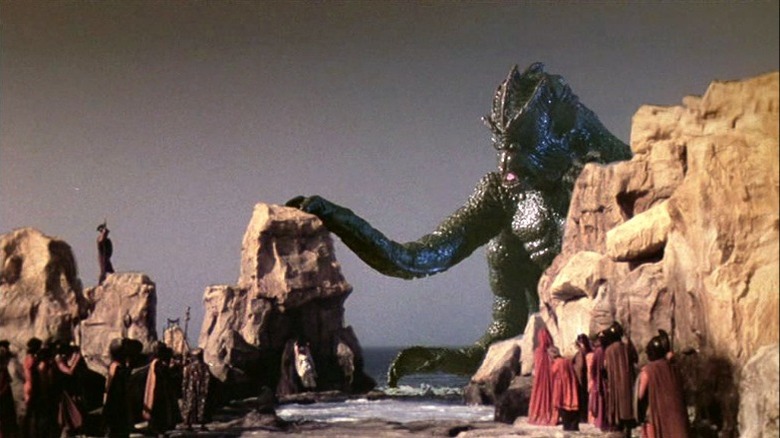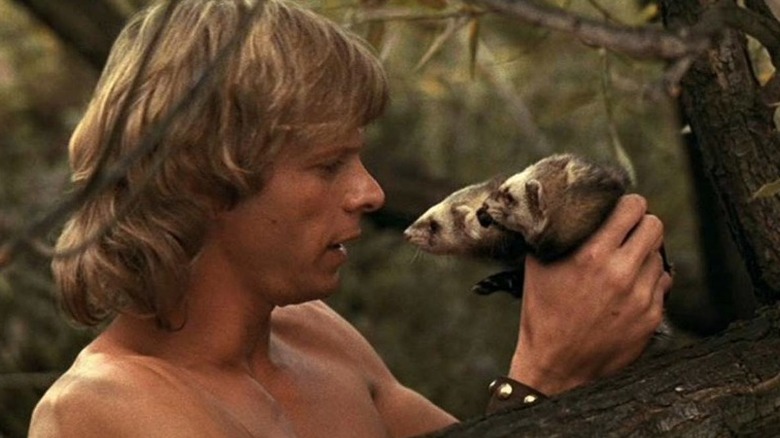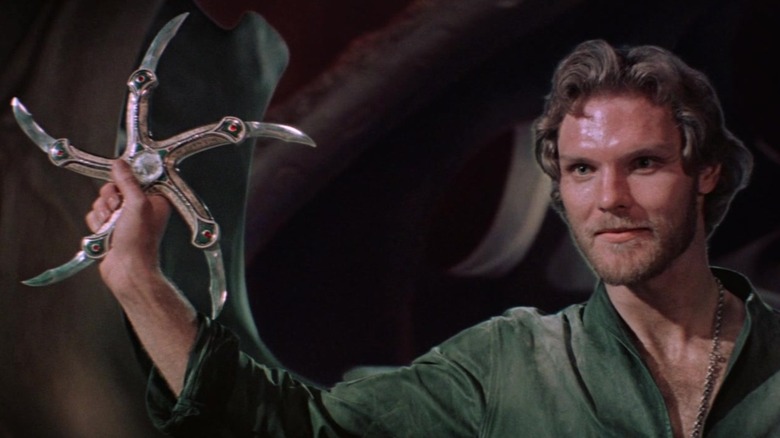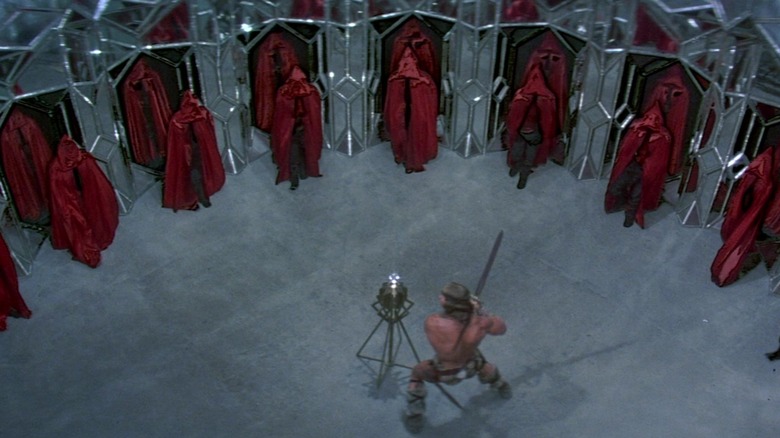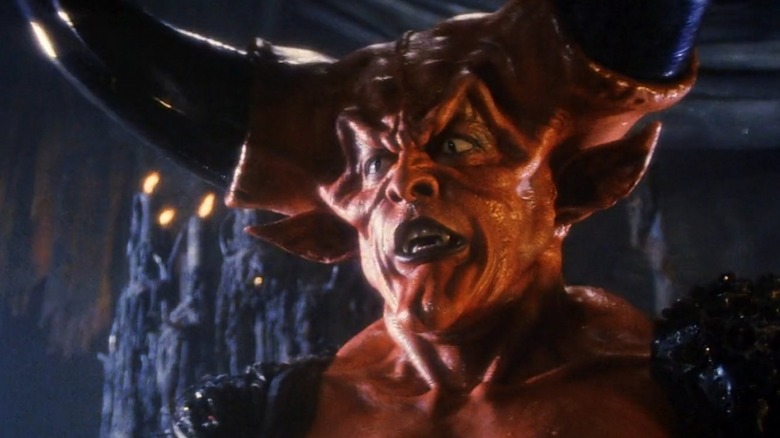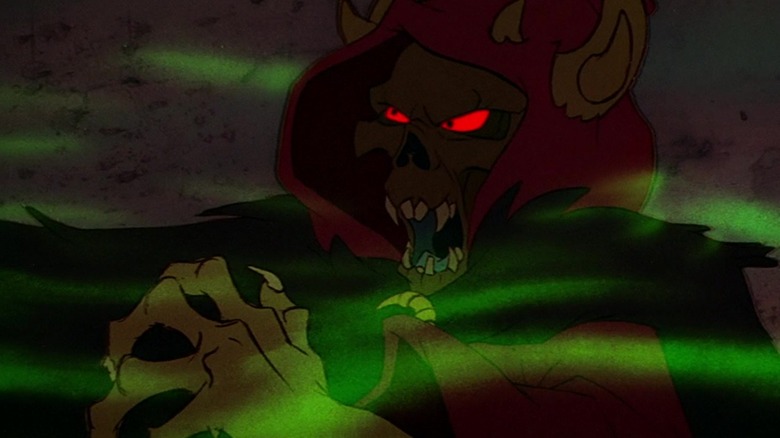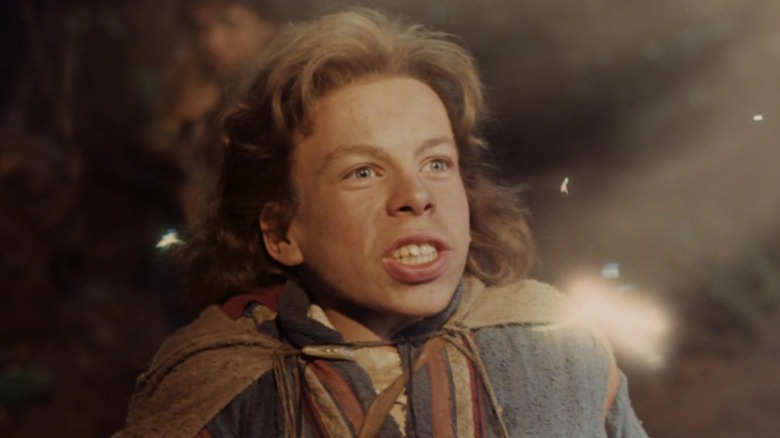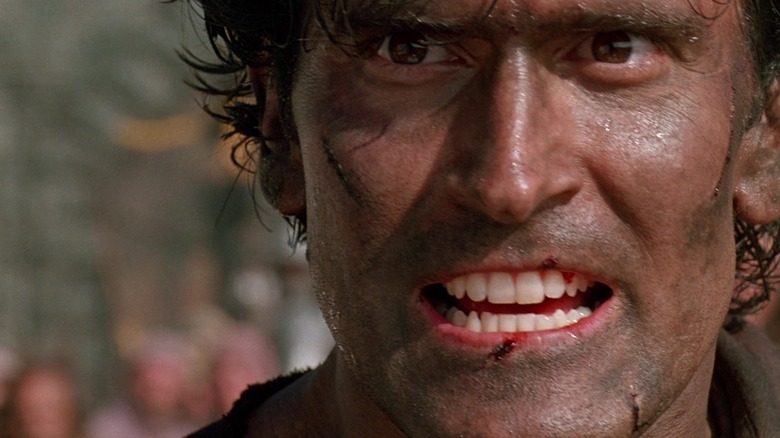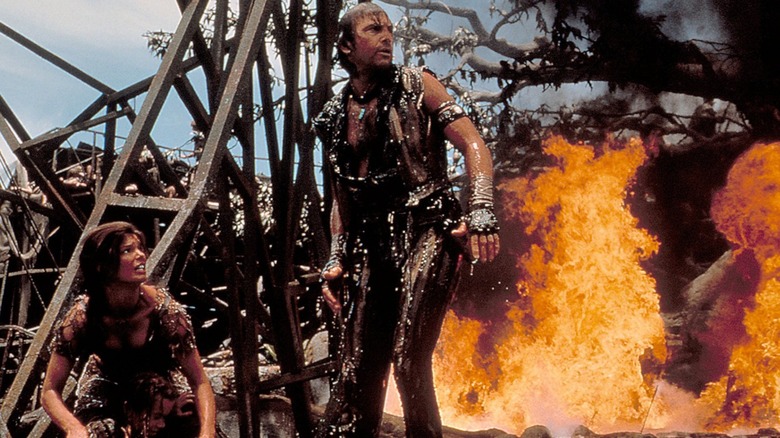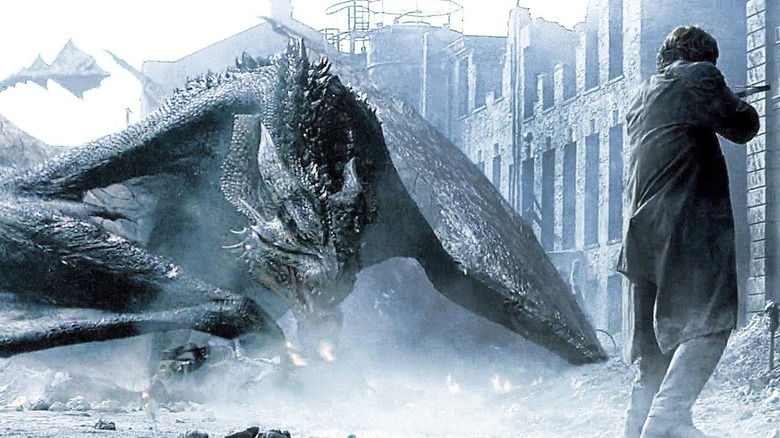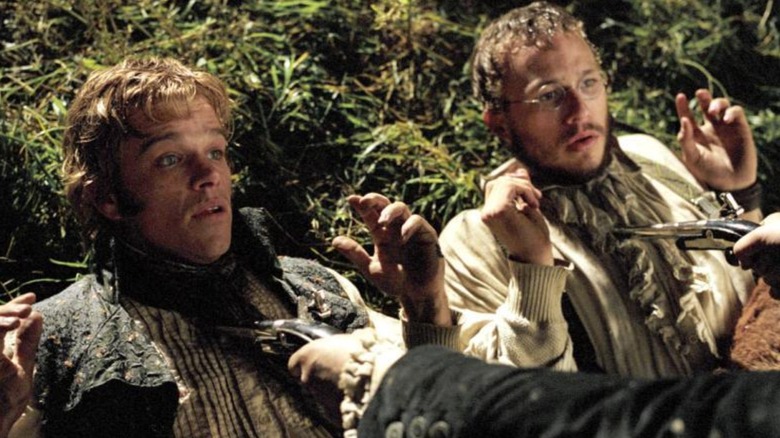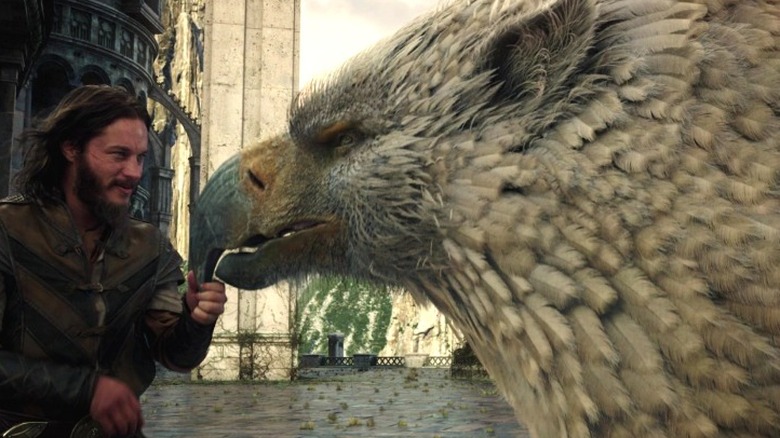Critically-Panned Fantasy Movies That Are Actually A Lot Of Fun
Epic fantasy has been a popular genre in the movies for nearly a century. Classics like "The Wizard of Oz," "Jason and the Argonauts," and "Snow White and the Seven Dwarves" attracted hordes of moviegoers; they also won awards and drew rave reviews from critics. But not every fantasy film gets two thumbs up. For every "The Lord of the Rings," there's a "Hobbit"; for every "Labyrinth," an "Eragon."
And yet, some of these films might make you sit up and cheer anyway. It's not just the swords and sorcery that make them fun; it's the diverse and complex characters, the bizarre and creative creatures, and the wild and innovative settings. Many fantasy films were lambasted by reviewers when they were released, but if you sit down to watch them today, you'll have a fantastic time.
Don't believe me? These 14 epic fantasy movies were panned by professional commentators, but they're still a blast to watch. To prove it, let's look at some of the critics' most scathing quotes about them, and then examine how the experts got it wrong.
The Lord of the Rings (1978)
"It would be difficult to recommend this movie to anyone not wholly absorbed by the uses of motion-picture animation or to anyone not familiar with Tolkien's home-made mythology." — Vincent Canby, The New York Times, Nov. 15, 1978
Thanks to director Peter Jackson and writers Fran Walsh and Philippa Boyens, we know all about Tolkien's homemade mythology, and don't have to worry as much about following the story of 1978's "Lord of the Rings." Instead, we can marvel at the psychedelic backgrounds of Ralph Bakshi's Middle-earth. We can revel in the thunderous drums and howling horns that drive the battle scenes. We can admire the gutsy decision by Bakshi to trace over footage of live-action actors, a process known as rotoscoping, in order to portray Tolkien's well-known characters. The animation in "The Lord of the Rings" will hold your attention; it brings the races of Middle-earth to life, and gives the Nazgûl a spectral presence. Even the lowly orcs, like the one who charges at Frodo with a spear in Moria, have a heft to their movement that's intimidating.
Bakshi's beautiful art adds depth and dimension to the film, making this a unique experience even if you know the story. As Canby and others critics point out in their reviews, the film occasionally becomes bogged down with lore and doesn't have a proper ending; this was supposed to be the first part in a series of films. Still, if you love the world Tolkien created and want to watch a faithful interpretation of his story, this unique experiment in filmmaking pays off.
Flash Gordon (1980)
"The expensive new version of Flash Gordon is a lot more gaudy, and just as dumb, as the original series..." — Variety Staff, December 31, 1979
I relish the bold gaudiness of "Flash Gordon" — the vibrant palace, the outfits as blood-red as Dale Arden's lips, the sky painted like a still-wet Easter egg dipped in water — and when I close my eyes, the opulence doesn't stop. Rock gods Queen jolt you with palatial high notes and soaring guitars. There's never a moment in the movie when you're not able to indulge in its swank environments and tawdry people. The more you look, the more you realize how wonderfully cheap it looks.
Roger Ebert had a great take on the film, saying that there's something fun about how "Flash Gordon" is "cheerfully willing to look as phony as it is." He's right. The set and costume designs are tacky, but not disingenuous. The movie is supposed to look like a toy version of the classic "Flash Gordon" comics — and, like any other act of play, it's best enjoyed in the company of others.
Clash of the Titans (1981)
"...an unbearable bore that will probably put to sleep the few adults stuck taking the kids to it." — Variety Staff, December 31, 1980
A head with snakes for hair. A flying horse. A clockwork owl. The kraken. It's all brought to life by stop-motion master Ray Harryhausen. Does this sound like a bore that'll put you to sleep? Many critics in 1981 didn't appreciate Harryhausen's artistry, which breathed life into these mythological beings. "Clash of the Titans" is Harryhausen's final feature film project, and it contains some of his finest work. I can't believe that someone could resist the charm of Bubo the owl, or not feel their heart race when Perseus is pursued by Medusa.
Variety called the film's writing lackadaisical. The plot is somewhat based on Greek mythology, and writer Beverley Cross delivers a pretty faithful depiction of Perseus' life. The story has a lot of moving parts, and the dialogue isn't particularly smart, but the script is not why "Clash of the Titans" remains a classic. Critics scoffed at the film's special effects in 1981, just a few years after the release of "Star Wars" and "Alien." Four decades later, though, you can admire Harryhausen and director Desmond Davis' craft. The fights with Medusa, the giant scorpions, and Calibos are the work of two filmmakers at the top of their craft.
The Beastmaster (1982)
"...dopey, occasionally-vicious adventure fantasy..." — Vincent Canby, The New York Times, August 20, 1982
"The Beastmaster" does not elaborately weave together stories and high-concepts like Christopher Nolan's movies. "The Beastmaster" is not esoteric and provocative like Ingmar Bergman's films. "The Beastmaster" does, however, feature mind-linked ferrets, scaled devourers who consume their enemies by wrapping them in their wings, and bondage-clad death guards whose rage is fueled by glowing ear leeches. It's a little dopey, but there's a reason why Dopey is the best dwarf: He's sweet, he's thoughtful, and he's a good friend.
"The Beastmaster" is a basic fantasy story. There's a prophecy about a child, an evil priest who fears it, a destroyed village, and a hero who's born out of the rubble. It's not complicated, but if I'm casually browsing streaming services, I'm not putting on Bergman or Nolan. I'm putting on Don Coscarelli. As a director, Coscarelli is not afraid to get a little weird — just look at "Phantasm" and "Bubba Ho-Tep." In "The Beastmaster," Coscarelli takes us on a trek that's sweet at times, but peppered with thoughtfully macabre creatures and quirky characters who will become old friends after a few (50-plus for me) viewings.
Krull (1983)
"The film's visual inventions, while distinctive, aren't interrelated enough to create an overall mood." Janet Maslin, The New York Times, July 29, 1983
"Krull" features a prophecy, a magic weapon, mythical creatures, and an invading space army. Let's call it classic high fantasy with a sci-fi twist. The movie came to be because of a fortunate intersection in nerdom, when the popularity of "Star Wars" and "Dungeons & Dragons" collided. We have to thank the confused suits who wanted to emulate the successes of both franchises, and gambled on wild ideas like "Krull."
Despite a few slowdowns, "Krull" picks up the pace in a few key scenes: when the Widow of the Web lures us into her woven crystalline prison, which even New York Times critic Janet Maslin admits "develops some emotional weight"; when the horses blaze a path of fire and James Horner serenades us with triumphant horns and strings; when the omniscient cyclops spears and deflates a shapeshifting clone. These moments lift "Krull" out of the swamps of boredom into the healthy air reserved for cult classics.
Conan the Destroyer (1984)
"Conan is a sort of cut-rate Hercules, the mythological hero of what's called the Hyborean [sic] Age, which, from what we see in 'Conan the Destroyer,' looks to be about 30 minutes east of Los Angeles by freeway." — Vincent Canby, The New York Times, June 29, 1984
The Conan sequel takes a different path than its predecessor, "Conan the Barbarian." The first movie is a dark, stern contemplation about the long upward struggle of a man who would become a legend. "Conan the Destroyer" is a campy road trip flick. The sequel eases up on the attitude, creating a lighter air that permeates the film and its actors. The casting director should be applauded. This time around, Arnold Scwharzenegger is joined on his journey by Wilt Chamberlain, Grace Jones, and Mako, the Academy Award nominee who later voiced Aku in "Samurai Jack."
Despite the size of her companions, Grace Jones soars above the other cast members, howling as she swings her bo staff. Together, this band of misfits take on a multitude of monsters and magic users. Vincent Canby is correct that "Conan the Destroyer" is not high cinema, but the movie is an exciting escape from our world. Critics who called "Conan the Destroyer" dumb and ridiculous are missing the point. It is dumb. It is ridiculous. That's what makes it fun.
Legend (1985)
"What might have been a pleasantly innocuous children's story becomes an enormous, lumbering FX machine into which the actors, particularly a nervous Tom Cruise, seem to disappear." — TV Guide Staff, TV Guide, 1985
Ridley Scott almost had something here. Almost. "Legend" is an ambitious dark fairy tale featuring makeup and special effects wizardry, but its magic doesn't extend too far outside of the visuals. I don't know that Tom Cruise looks as nervous as TV Guide says he does, but I do think that Cruise is out of place in this setting. Before "Legend," he'd had his feet planted squarely on the floors of school hallways, football fields, and parent-free mansions. Tim Curry, on the other hand, is in his element. He embodies the Lord of Darkness and makes the most of the makeup that earned the movie an Academy Award nomination.
That said, most fairy tales can't be stretched into full-length features without some growing pains. The snarky TV Guide staff is right in that the movie does lumber along at times, especially when it's supposed to be exciting. Ridley Scott had all of the pieces he needed to create a fantasy classic but he just couldn't fit them together. Still, there's enough spectacle here to enchant you for 90 minutes — or 113, if you watch Scott's director's cut. He always seems to have one, doesn't he?
The Black Cauldron (1985)
"...professionally put together as it is, many of the ingredients may seem programmed to those who have seen some of the others." — Walter Goodman, The New York Times, July 26, 1985
For most of the 20th century, Disney rarely missed a step. After making many critical darlings in its first 24 feature-length animated films, the studio applied its tried-and-true formula to the epic fantasy genre, expecting to make magic once again with "The Black Cauldron." Instead, they got a formulaic fantasy. Critic Walter Goodman said that the characters, the magic, and the moments all felt too familiar and overworked.
That was true in 1985. The thing about time, though, is that it makes treasures out of anything crafted with this kind of care. The landscapes and characters are gloriously painted by young artists like John Lasseter and Tim Burton. The voice actors' emotions and spirits match the vibrancy on screen, especially John Hurt as The Horned King. Elmer Bernstein's score dances between playful and ominous. The story, though, is a bit choppy.
Looking back, it's easy to see what went wrong. Disney's staff was overwhelmed by the ambition behind the project, and the studio's new management butchered it in post-production. In fact, according to Slate, the new executives toyed with axing Disney's animation department entirely. It's almost a miracle that "The Black Cauldron" exists in any form. So, you should take a moment to bask in a style of handcrafted artistry that's been mostly absent at Disney for the better part of a generation.
Willow (1988)
"...the fantasy wheels grind to a halt, bogged down in Lucas' flat, derivative story, and not helped in the least by director Ron Howard's clumsy steering." — Desson Howe, The Washington Post, May 20, 1988
I remember first seeing the teaser trailer for "Willow," in which a horde of skull-masked villains thundered toward the screen. It was all I could think about as I sat through the bland "Batteries Not Included." I couldn't wait for next summer. Then, I finally watched the movie and ... would probably have labeled it "bogged down" and "clumsy," just like Desson Howe. The movie had such potential — how could it go wrong with George Lucas and Ron Howard leading the charge?
Yet, here I am devising a list of panned-but-fun fantasy movies more than three decades later. This one makes the list because there is just enough magic, personality, and care to make it fun. Warwick Davis cannot carry the film by himself; luckily, he's backed up by a brooding Val Kilmer and the effervescent Brownies, brought to life by ILM effects artists. The effects are impressive for 1988, and wouldn't be out of place in some movies today. "Willow" is worth an evening, especially if you plan to watch the new "Willow" Disney+ series.
Army of Darkness (1992)
"The movie isn't as funny or entertaining as 'Evil Dead II,' however, maybe because the comic approach seems recycled." — Roger Ebert, The Chicago Sun-Times, February 19, 1993
In 2003, "Army of Darkness" had an army of fans. It also had an army of haters. Some critics, like Roger Ebert, wanted to see director Sam Raimi ascend to a new level of comedic horror after "Evil Dead 2." Instead, they got more of the same, but on a bigger scale. Raimi brought out all his toys to expand his Ashiverse (let's make that a thing), and critics both praised the non-stop action and complained about being visually bludgeoned into submission. The story is also divisive; some felt it slogged along, while others appreciated its tongue-in-cheek attitude.
Step back to look at that first paragraph. What do you see? Chaos. Raimi's "Evil Dead" movies came at you from all directions. "Army of Darkness" settles more into a formal narrative than its predecessors, but still chases you from beginning to end with its wit, scares, and inventiveness. Ebert calls it a "goofy, hyperventilated send-up of horror" that seems like a "cardiovascular workout for its stars." I couldn't have written a better endorsement.
Waterworld (1995)
"'Waterworld' isn't 'Fishtar,' but Kevin Costner's pricey, post-apocalyptic sloshbuckler isn't a seafaring classic either." — Rita Kempley, The Washington Post, July 28, 1995
Do you remember when "Waterworld" sailed into our lives? Stodgy critics lamented that the bilge soiled their newly-polished loafers, whereas us genre fans cheered on the artistry with which the filmmakers brought this world to life. Yes, "Waterworld" is a little soggy. The main set starts to feel like a prison because we spend way too much time there. When we get out to sea, though, Rita Kempley of the Washington Post is correct: It isn't a seafaring classic, but it is big, loud, and — what's the magic word, kids? — fun!
Yes, Rita, "Waterworld" is not "Fishtar." I love the creative burn, but I walked out of "Ishtar" as an eight-year-old. As an 18-year-old, I sat and marveled at "Waterworld," getting splashed in the face by its big sets, big stunts, and big social commentary. I'll allow the term "sloshbuckler," Rita (her wordplay is fantastic, right?), but I don't see it as a pejorative. If you're going to dive into an ocean-based $175 million epic, you better do so with confidence. It's clear that the crew, the writers, the actors, and the stunt workers all had the intention of swan-diving in head first. They may have belly flopped instead, but what a splash they made.
Reign of Fire (2002)
"...the bad CGI, the choppy pacing, the comically intense acting, the repetition, the dullness and mostly the idiot plot." — Peter Travers, Rolling Stone, July 25, 2002
Critics roasted "Reign of Fire" when it first came out. Peter Travers' references to its "dullness" and "idiot plot" are mild compared to SFGATE critic Mick LaSalle's succinct review, in which he calls it "truly awful." The movie does have flaws, including its premise. Why show us what happens before and after dragons awaken and nearly destroy mankind? That's skipping over the stuff we really want to see. Travers is also correct that the premise — you must kill the big dragon to stop all the dragons — doesn't make a ton of sense. Yet, there's still something to "Reign of Fire." What is it? Oh, right, dragons.
Many of the dragon effects are impressive, though, as Travers points out, they aren't always perfect. I like that the dragons are not complicated beings. They exist mainly to feed. That implies a simple, soulless evil. The movie won't make you a philosopher, but that's not its job. It's here to tickle your lizard brain, the part of you that occasionally craves dusty but beautiful people battling fire-breathing dragons with hi-tech boom sticks.
The Brothers Grimm (2005)
"...the best thing to be said about this expensive but drab wannabe mirthmaker is that it has some of its director's quirky touches." — Mike Clark, USA Today, August 25, 2005
Terry Gilliam walks a line between brilliant and nonsensical. Sometimes it takes a couple of viewings of his films until you settle on brilliant. "The Brothers Grimm," though, is not brilliant no matter how often you watch; even Gilliam admits that it's not what he was aiming for, largely because the Weinsteins wouldn't fully hand it over to him. The plot is simple enough: Two con men who pretend to fight witches for money have to save a village from real evil. It's a tried-and-true concept. Why doesn't it work? Mike Clark says stars Matt Damon and Heath Ledger aren't enchanting and the world is just too drab.
Time may be on our side here, folks. Every fantasy movie produced in the last decade is drab; darkness is a trend that we've grown accustomed to. As for the actors, Matt Damon has enough screen cred now that we enjoy seeing him cower at the movie's ludicrous threats, and Heath Ledger is like an old friend who's nice to see on screen. It doesn't matter that the Weinsteins have their hands all over this movie. Gilliam's "quirky touches," as Clark calls them, are also all over it. That's reason enough to spend a few beans to rent "The Brothers Grimm."
Warcraft (2016)
"...despite bringing the game world to life with impressive visual effects, it gets impaled by a muddled plot and hammy performances." — Steve Tilley, Toronto Sun, June 9, 2016
When I first saw "Warcraft," I feared it would be one long cut-scene — the part of a video game during which I usually get up to grab a beverage. I'll admit, I was wrong. The film's visual effects are more impressive than those in "World of Warcraft," and may even top the ones in "She-Hulk: Attorney at Law." There are scenes in which the animated orcs look more alive than the real-life humans. Critic Steve Tilley is correct in that the acting is hammy — it's reminiscent of a Saturday afternoon movie on SyFy — but that's part of what makes it fun. I can't imagine an actor with the chops of someone like Glenn Close being in ... wait, she's in this? Well, I'll be damned.
Maybe Close should've provided narration to fill the gaps — as Tilly points out, the story is a little unclear — but you can get the gist easily enough. As the plot advances, the characters are forced to make big decisions about who they are. That includes giving up a baby to fate, killing a king for love, and daydreaming about banging a half-orc. Those moments help you invest in these people, no matter how dead their eyes are (I'm talking about the humans, not the orcs). This is not a movie you're going to check out in 35mm at the local art house theater, but if you're hung over on the couch on a Saturday morning, go ahead and give "Warcraft" a shot. You may be surprised at how little you pause it to grab a beverage.
